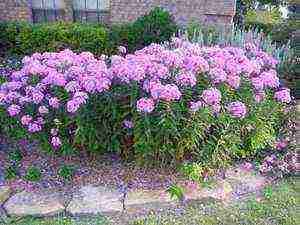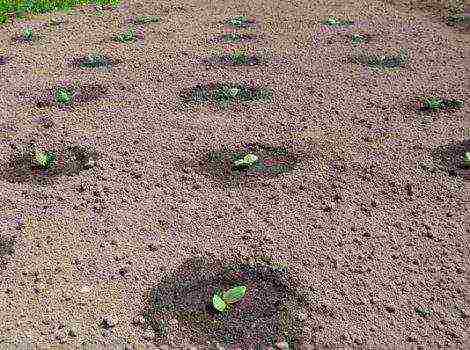Content
- 1 Features of forsythia
- 2 Features of growing forsythia
- 3 Planting forsythia in open ground
- 4 Care features
- 5 Forsythia after flowering
- 6 Types and varieties of forsythia with photos and names
- 6.1 Forsythia European (Forsythia europaea)
- 6.2 Forsythia giraldiana
- 6.3 Forsythia hanging, or drooping, or drooping (Forsythia suspensa)
- 6.4 Forsythia dark green (Forsythia viridissima)
- 6.5 Intermediate forsythia (Forsythia x intermedia)
- 6.6 Forsythia snow, or white (Forsythia abeliophyllum)
- 6.7 Forsythia ovoid (Forsythia ovata)
- 7 Conditions for planting forsythia in the open field
- 8 Timing of planting forsythia in the ground
- 9 Planting forsythia in open ground
- 10 Care for forsythia after planting in the open field
- 11 Reproduction of forsythia in the open field
- 12 1 Common types
- 13 2 Planting in open ground and further care
- 14 Landing
- 15 Care
- 16 Pruning
- 17 Reproduction
- 18 Description
- 19 Types and varieties
- 20 Most common varieties in Europe
- 21 Growing
- 22 Wintering
- 23 Pruning
- 24 Location
- 25 Why does the plant not bloom
- 26 Diseases and pests
The genus of not very large trees and shrubs forsythia (Forsythia), or forsythia, is a representative of the olive family. They bloom at the beginning of spring with flowers of a rich yellow color. This genus is considered very ancient, which explains its widespread occurrence. So, in East Asia, you can see 6 different species of this plant at once (in Korea, Japan and China). And in European countries you can find only one species - European forsythia (Forsythia europaea), most of the plants are found in the Balkans. This plant was named after the Scotsman W. Forsyth, who was a botanist, chief gardener of Kensington Palace, and also one of the founders of the Royal Horticultural Society. For the first time, this plant got from China to European countries thanks to Forsyth.
Features of forsythia
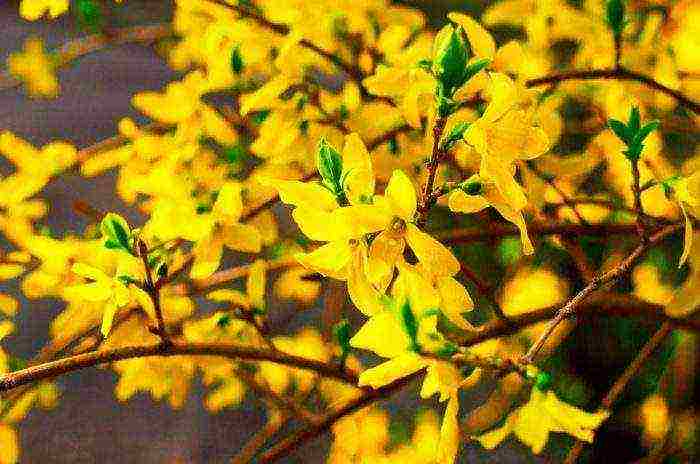
Forsythia is not a very large tree or shrub, the height of which can vary from 1 to 3 m. The brownish-gray bark has a rough texture. In certain species, the leaf plates are trifoliated. However, most often they are oval, simple, oppositely located, do not have stipules, with a serrated edge, in length they can reach 2-15 centimeters. The rich yellow flowers are bell-shaped. Forsythia blooms at the beginning of the spring period, while the duration of flowering is 20 days (in some cases longer). The fruit is a capsule with winged seeds.
Features of growing forsythia

Today in European countries most squares, private gardens and city streets are decorated with forsythia. It is considered a symbol of the arrival of spring. Imagine early spring, when everything is still gray and nondescript on the streets, and suddenly your gaze catches out forsythia blazing with its bright flowers. A distinctive feature of this shrub is its very early flowering. Also, this plant has won great love among gardeners due to the fact that it does not impose special requirements on growing conditions and care. The main features of cultivation:
- such a plant grows best in a well-lit area, but it can also be grown in shade;
- suitable soil must be limed;
- it is recommended to plant next to conifers of a dark green color.
In autumn, the green foliage changes its color to purple-purple or golden, which makes the plant highly decorative again.
Planting forsythia in open ground
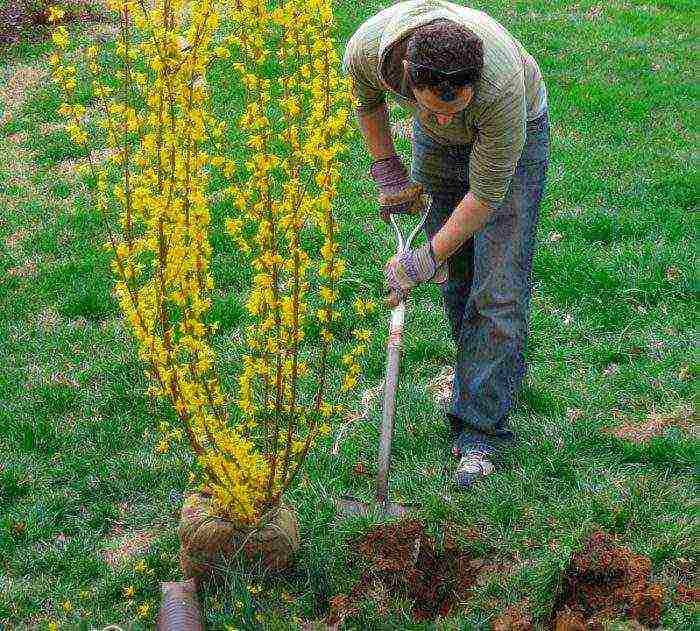
What time to plant
Forsythia can be planted or transplanted in spring or early autumn, before the frost begins, because the plant must take root well before the frost begins.This plant grows well in the shade, but it prefers a sunny area, which must be protected from gusts of wind. The quality of the soil is not important for this plant, but it feels best in dry, slightly alkaline soil. In the event that the land on the site is acidic, then it is recommended to bring wood ash into it for digging.
Landing features
The planting pit should have a size of 50x50x60 centimeters, while the root system of the planted plant should be at a depth of 0.3 to 0.4 m.When planting several specimens at once, a distance of at least 150 centimeters should be maintained between them. At the bottom of the prepared planting pit, a drainage layer of crushed stone and broken brick should be laid, the thickness of which should be from 15 to 20 centimeters. From above it is covered with a layer of sand, the thickness of which should be 10 centimeters. After that, a soil mixture is poured into the pit, consisting of sand, leafy earth and peat, taken in a 1: 2: 1 ratio, to which 0.2 kg of wood ash must be added. Then the seedling must be placed in a prepared hole, which is filled with soil and well compacted. The planted forsythia must be watered abundantly. When planting in spring, the seedling will need to be looked after as an adult plant. If the planting was carried out in the fall, then no matter what kind of plant was planted, it will be necessary to cover the near-trunk circle with a layer of mulch. For the winter, the plant must be covered. In this case, the covering material should only be used that allows air to pass through so that the flower buds do not begin to rot during small thaws in winter.
Care features
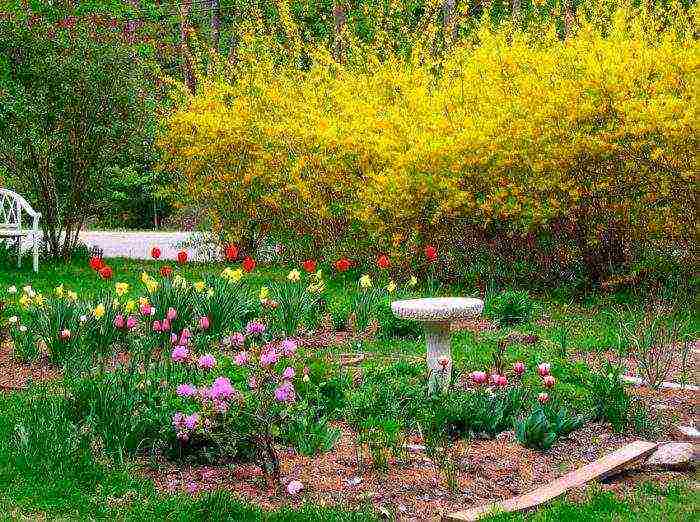
It is necessary to care for forsythia in the same way as for other shrubs grown in the garden. If it rains regularly in summer, then you will not have to water this plant. This should be done only with prolonged drought 1 or 2 times in 4 weeks, while 10 to 12 liters of water are taken for 1 bush. After the plant is watered, weed and loosen the soil to the depth of the shovel bayonet, this is the only way to ensure normal air access to the root system. When loosening is finished, sprinkle the trunk circle with a layer of mulch (dry soil or compost).
Forsythia should be fed 3 times during the season. For the first time, you need to feed the plant at the beginning of the spring period. To do this, a sufficiently thick layer of manure (necessarily rotted) is laid out on the surface of the trunk circle, make sure that it does not touch the branches or the trunk. Then it is watered with plenty of water. Manure will become not only organic fertilizer for the plant, but also mulch. Complete mineral fertilizer (per 1 square meter from 60 to 70 grams) should be applied to the soil in April. When the plant blooms and the laying of flower buds for next year begins, it will need to be fed with Kemira-universal (for 1 square meter from 100 to 120 grams).
Reproduction of forsythia

For reproduction, vegetative methods are most often chosen. For example, cuttings. Harvesting green cuttings should be carried out in June, while their length should be approximately 15 centimeters. At the cutting, it is necessary to cut off the leaf plates located below, then it must be treated with a drug that stimulates the growth of roots (Epin, Kornevin or Heteroauxin). It is planted in a greenhouse, using sand or perlite. Lignified cuttings, which are harvested in October, are also suitable for reproduction, for rooting they are planted directly in open soil, while 2 or 3 buds should remain above its surface. Do not forget to cover the cuttings with fallen leaves for the winter. In the springtime, it is necessary to remove the shelter, after which the cuttings will begin to grow actively, and in the fall they will already become full-fledged seedlings. For reproduction, you can use layering.In order to get them, you need to choose a stem growing very close to the surface of the site in summer or autumn. At the base, it is pulled over with wire, and an incision should be made in the bark on the surface that faces the ground. The stem is fixed on the soil surface and covered with nutritious soil. Layers take root in a relatively short period of time. In springtime, it is necessary to separate the cuttings from the parent plant, and after only 12 months it will begin to bloom.
It is possible to grow forsythia from seeds, but only specialists resort to this method of reproduction.
Pruning forsythia
Young bushes need only sanitary pruning, during which all dried, injured, and frost-damaged stems are removed. If the forsythia is adult, then in spring only the frozen tips of the branches are cut off from it. The main haircut is done in the summer, when the bush has faded. Those branches that have faded should be cut off by ½ part, while dried and old ones should be cut at a height of 40 to 60 mm from the soil surface, in this case young side shoots will go from them. With the help of pruning, you can control the height, density and shape of the crown, which can be spherical or cupped. In the event that an old bush needs rejuvenating pruning, then all its branches must be cut to a height of 4 to 6 centimeters or shortened by 2/3, thanks to this, young shoots will begin to actively grow. However, very often it is impossible to carry out anti-aging pruning, because from this forsythia it grows very much, but the flowering stops completely. As a rule, a rejuvenating haircut is recommended once every 3 or 4 years.
Diseases and pests

This plant is highly resistant to diseases and pests. In rare cases, the bush can be affected by moniliosis, wilting or bacteriosis. A bush infected with wilting should be treated with a solution of foundationol (2–5%). If forsythia is struck by bacteriosis, then in this case it will have to be dug up and burned. If brown spots have formed on the surface of the leaf plates, this means that the plant is sick with moniliosis. In this case, it is recommended that all affected parts of the plant be cut out and thoroughly cleaned to healthy tissue. Also, the bush can suffer from nematodes, in this case, the soil is disinfected with Carbation.
Forsythia after flowering
To prevent forsythia from freezing in winter, it should be covered. To do this, sprinkle the trunk circle with fallen leaves, while the layer thickness should be 10 centimeters. The branches are bent to the soil and fixed in this position, then the bush is covered with spruce branches. At the very beginning of the spring period, the shelter must be removed, and the branches must be freed, while the fallen leaves must be removed from the trunk. If the bushes are still young, then they are covered with spruce branches for the winter. If a lot of snow falls in winter, then forsythia can do without shelter, but no one can accurately predict the forecast for the whole winter.
Types and varieties of forsythia with photos and names
Forsythia European (Forsythia europaea)
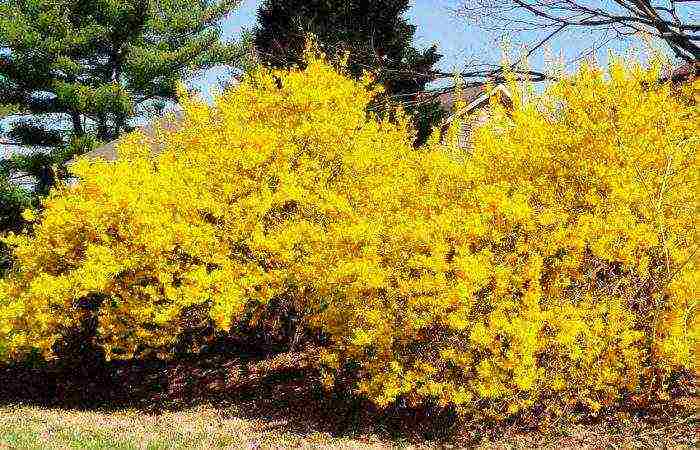
This species is most popular with gardeners living in mid-latitudes. In height, such an upright shrub can reach 200 centimeters. All-edge sheet plates have an oblong shape and a length of about 7 centimeters. The color of single bell-shaped flowers is yellow-golden.
Forsythia giraldiana
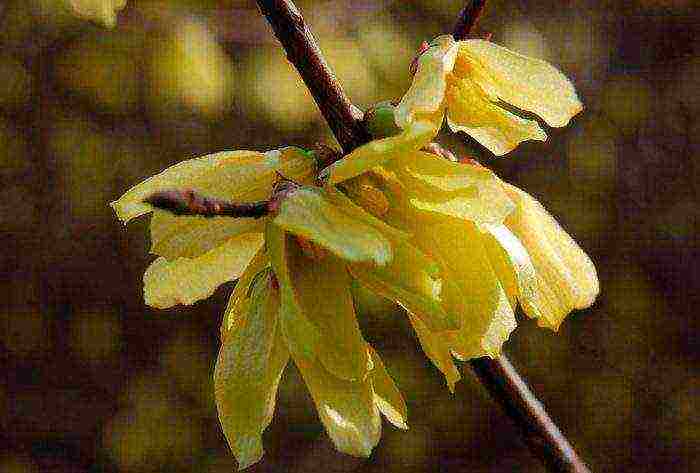
This species is very similar to European forsythia, however, it is less frost-resistant. In height, the bush can also reach 200 centimeters. Almost all shoots are straight, but they are colored brownish-yellow and are tetrahedral. Dark green elliptical leaf plates reach 10 centimeters in length. Blooming is observed in May. Graceful large pale yellow flowers have twisted petals.
Forsythia hanging, or drooping, or drooping (Forsythia suspensa)
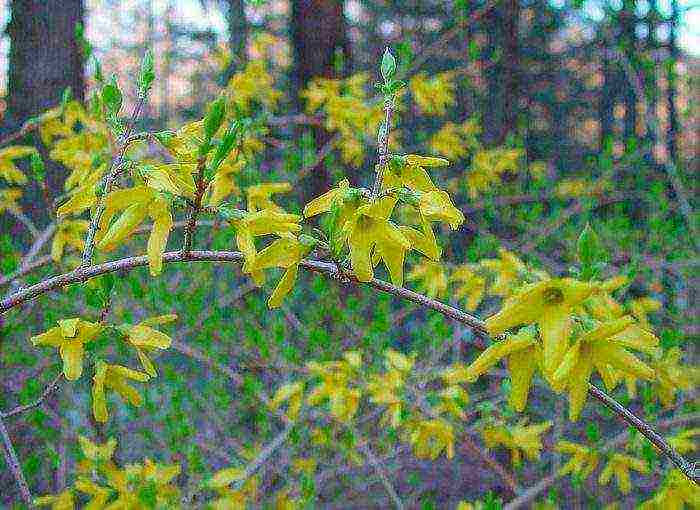
This shrub with a spreading crown can reach a height of 300 centimeters. Thin tetrahedral arcuate drooping branches have an olive or brown-red color. On old stems, leaf plates are simple, while on growth ones they are trifoliate. Large (diameter about 25 mm) yellow-golden flowers are collected in several pieces in bunches. Several forms are cultivated:

- Variegated (forsythia variegata). The color of the flowers is rich yellow. The leaf plates are pale yellow, variegated.
- Fortune (forsythia fortunei). The flowers are dark yellow in bunches. Narrow leaf plates are trifoliate.
- Purple stem (forsythia artocaulis). The stems are dark red. At the moment of opening, the leaf plates are painted in the same color.
- Other forms: forsythia of Zimbold, forsythia deceiving, forsythia hanging from Fortune.
Forsythia dark green (Forsythia viridissima)

The height of the shrub does not exceed 300 centimeters. Its green branches are directed upwards. Densely growing simple leaf plates have a lanceolate-oblong shape, their upper part is serrated. They are colored dark green, 15 centimeters long and 4 centimeters wide. Small bunches consist of flowers, which are painted in a rich yellow-green color. Differs in drought resistance.
Intermediate forsythia (Forsythia x intermedia)
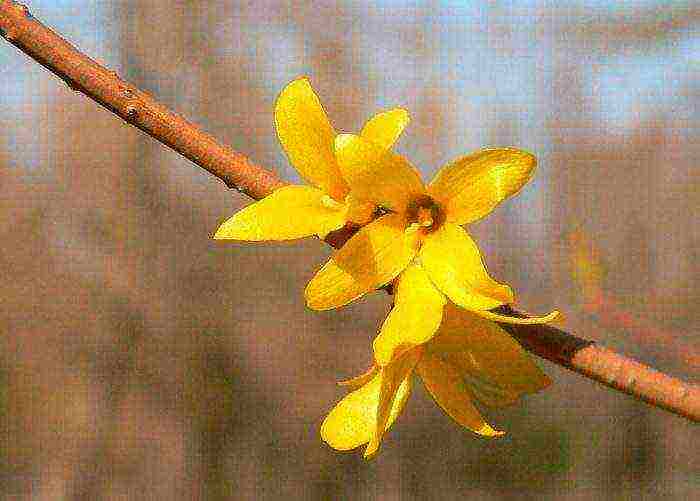
This hybrid was created by crossing dark green forsythia and drooping forsythia. It can reach a height of 300 centimeters. The bush begins to bloom only after he turns 4 years old. Leaf plates, as a rule, are oblong with a serrated edge, but trifoliate are also found, they reach 10 centimeters in length. They are dark green in color, while their color remains unchanged until late autumn. The color of the flowers is rich yellow, they are collected in bunches of several pieces. Bloom is observed in April and May. This shrub is fast growing and resistant to frost and drought. Varieties:

- Beatrix Farrand... The shrub reaches a height of 400 centimeters. The rich yellow flowers have a strip of dark yellow color at the base.
- Denziflora... The height and diameter of the bush are equal to 150 centimeters. The twisted flowers are light yellow. Flowering is observed in May, and it lasts 15–20 days. Does not tolerate frost.
- Spectabilis... This variety is one of the most beautiful. The height of the bush is about 100 centimeters, and its diameter is 120 centimeters. In the warm season, the leaf plates have a green color, which in autumn changes to rich yellow and purple. The diameter of the dark yellow flowers is about 45 mm, flowering begins in the last days of April.
Forsythia snow, or white (Forsythia abeliophyllum)
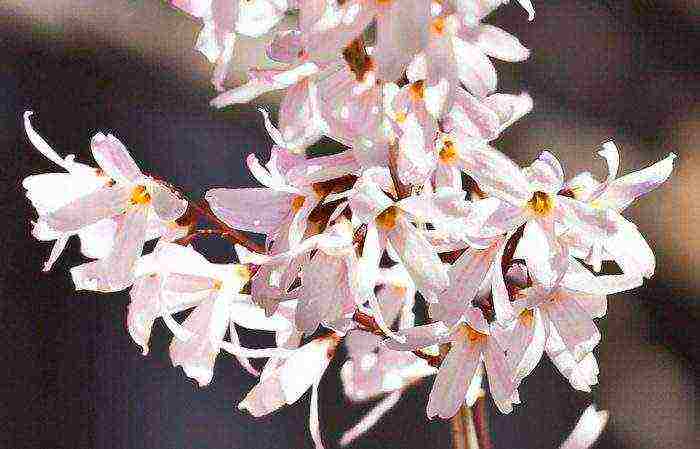
The height of the bush can vary from 150 to 200 centimeters. The length of the oval leaf plates is about 8 centimeters, their seamy surface turns purple in the summer. The flowers are white and have a yellow throat. The color of the buds is light pink.
Forsythia ovoid (Forsythia ovata)

The height of the bush can vary from 150 to 200 centimeters. The spreading branches are yellow-gray in color. The length of the leaf plates is about 7 centimeters, they are painted in a rich green color in summer, which changes to purple in autumn. The diameter of single flowers is about 20 mm, their color is rich yellow. This species begins to bloom earlier than others. It is fast growing and resistant to frost and drought. The most popular varieties are:

- Spring Glory... The height of the bush is about 300 centimeters. Leaf plates are green in summer, and in autumn they become variegated (from dark purple to light yellow). Lush bloom is observed in May. Large flowers have a rich yellow color.
- Tetragold... The height of the shrub is about 100 centimeters. The diameter of the dark yellow flowers is about 30 mm. Flowering begins in the second half of April.
- Goldsauber... This variety is very valuable and popular. Large flowers are yellow-golden in color. Resistant to frost. Flowering begins in the second half of April and lasts approximately 20 days.
 Forsythia (Forsythia) or forsythia is a plant in the form of shrubs or small trees. It is a member of the Olive family.The main feature of forsythia is considered to be its early flowering, the bush is covered with bright yellow flowers in early spring, long before its first leaves appear.
Forsythia (Forsythia) or forsythia is a plant in the form of shrubs or small trees. It is a member of the Olive family.The main feature of forsythia is considered to be its early flowering, the bush is covered with bright yellow flowers in early spring, long before its first leaves appear.
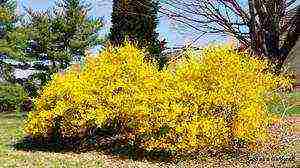 This genus is one of the most ancient on earth. First of all, this is proved by a very wide natural habitat. Six types of forsythia originate from East Asian countries such as Japan, China and the Republic of Korea. Only one species grows in Europe Forsythia europaea or translated from Latin European forsythia. Most often it can be found on the Balkan Peninsula and in Germany.
This genus is one of the most ancient on earth. First of all, this is proved by a very wide natural habitat. Six types of forsythia originate from East Asian countries such as Japan, China and the Republic of Korea. Only one species grows in Europe Forsythia europaea or translated from Latin European forsythia. Most often it can be found on the Balkan Peninsula and in Germany.
The plant got its name thanks to the Scottish botanist William Forsyth. He is one of the founders of the Royal Horticultural Society, and is also known for being the main gardener of Kensington Palace for a long time. It was William who introduced forsythia to Europe, borrowing it from the wild flora of China.
> Description
Forsythia grows in the form of small trees or bushes. She can reach from one to three meters in height... The trunk of this plant is covered with rough gray-brown bark. Most species have simple opposite leaves without stipules. They are oval in shape with jagged edges, can be from two to fifteen centimeters in length. On the shoots they are arranged crosswise - in pairs, two at each node. Some species boast trifoliate leaves, their plate is divided into three parts: two lateral and one central.
 The forsythia bloom period begins in early spring and lasts on average up to three weeks, but sometimes it can last longer. The inflorescences are bright yellow in color, consist of flowers that resemble bells in their shape. In their place, the fruits of the plant are formed - capsules filled with winged seeds.
The forsythia bloom period begins in early spring and lasts on average up to three weeks, but sometimes it can last longer. The inflorescences are bright yellow in color, consist of flowers that resemble bells in their shape. In their place, the fruits of the plant are formed - capsules filled with winged seeds.
Forsythia begins to bloom long before the first foliage appears, then the flowers are replaced by green leaves, which acquire a purple hue closer to autumn.
Types and varieties
Forsythia - spring messenger, with its aroma and bright, sunny bloom, it decorates gray streets and reminds people of the imminent arrival of heat. To date, within the framework of botany, seven main species of this beautiful flowering plant have been recorded:
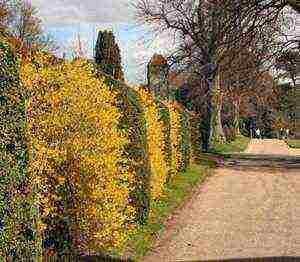 Forsythia europaea or European forsythia.
Forsythia europaea or European forsythia.- Forsythia ovata or ovoid forsythia.
- Forsythia x intermedia or intermediate forsythia.
- Forsythia hanging, drooping or drooping - Forsythia suspensa.
- Forsythia abeliophyllum - Snow or white forsythia.
- Forsythia viridissima or dark green forsythia.
- Forsythia giraldiana or forsythia giralda.
Let's take a closer look at the most popular ones.
> European forsythia
This species is considered the most common in Russia. Such popularity is due to the unpretentiousness of the plant and its frost resistance - it is able to develop well and bloom even in climatic conditions of middle latitude and Siberia.
Forsythia European looks like a short one upright shrub... She can only grow up to two meters in height. She has oblong, whole-edged (without denticles and grooves) leaves up to seven centimeters in length. The flowers grow singly, their shape is similar to bells and are colored yellow with a golden tint.
Forsythia ovoid
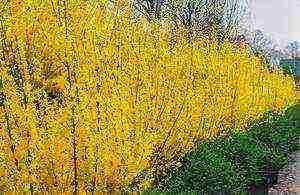 Ovate forsythia is a small shrub that grows from one and a half to two meters in height... They have spreading branches covered with gray bark with a yellowish tinge. The leaves can be up to seven centimeters long. In summer, they are painted in bright green, and closer to autumn they acquire a purple hue.
Ovate forsythia is a small shrub that grows from one and a half to two meters in height... They have spreading branches covered with gray bark with a yellowish tinge. The leaves can be up to seven centimeters long. In summer, they are painted in bright green, and closer to autumn they acquire a purple hue.
Bright yellow inflorescences consist of single, medium-sized flowers with a diameter of up to two centimeters. The flowering period of this species begins earlier than that of other forsythia.
Plants tolerate winter cold, dry periods and grow quite quickly. The most popular varieties related to this species:
- Tetragold - shrub rarely exceeding one meter in height. The flowering period begins in mid-April. The inflorescences consist of single dark yellow flowers with a diameter of up to three centimeters.
- Goldsauber - is considered a very valuable variety. It is very popular among gardeners due to its large yellow flowers with a golden hue and frost resistance. The flowering period begins in April and lasts about three weeks.
- Spring Glory - shrub up to three meters in height. In summer, the crown has a rich green color. Closer to autumn, it acquires an additional shade from pale yellow to dark purple, which is why it becomes quite variegated. The bloom is very abundant, the flowers are large, painted in bright yellow color.
> Intermediate forsythia
Intermediate forsythia is a hybrid created by crossing dark green and drooping forsythia. It grows up to three meters in height and begins to bloom only in the fourth year after planting.
She has oblong leaves, up to ten centimeters in length... They are most often toothed, but plants with trifoliate foliage can be found. The crown is painted in a dark green color, which does not change until late autumn. Bright yellow flowers form inflorescences of several pieces. The flowering period runs from April to May. The species is very winter-hardy, drought-resistant, grows quickly and well. Varieties:
- Spectabilis - is considered a very beautiful variety. The bushes are low, only a meter high. The main feature is the crown of this species. It is very thick and lush, can reach one hundred and twenty centimeters in diameter. In summer, the foliage is colored green, in autumn it turns purple or bright yellow.
- Denziflora —Small bush, can reach one and a half meters in height or less. The volume of the crown is usually equal to the height of the plant. The flowers are twisted, have a pale yellow color. It begins to bloom in March, the inflorescences last for about two to three weeks. This variety is afraid of frost.
- Beatrix Farrand - bushes up to four meters high. The flowers are bright yellow with dark yellow stripes at the base.
Planting forsythia
The early onset of the flowering period favorably distinguishes forsythia against the background of other shrubs. Unpretentiousness to the location and care only add to its popularity among flower growers. Noting some of the features that should be considered when growing this wonderful flowering bush:
- This plant is very light-requiring, but grows well even in the shade.
- Forsythia prefers calcareous soils.
- Closer to autumn, the green crown of the bush acquires a golden or purple-violet hue, which again attracts the attention of all passers-by.
- Experienced gardeners prefer to place forsythia against the background of dark green conifers, since in such a place it looks most impressive.
When to plant forsythia
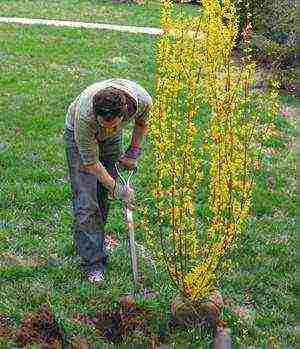 Transplanting and planting forsythia should be done in spring or early autumn, before the onset of frost, so that it can take root even before winter. The most suitable place for this plant, with good lighting and partial shade, well protected from wind and drafts. Of course, forsythia feel good even in the shade, but nevertheless, it is better to choose bright places for heat-loving bushes.
Transplanting and planting forsythia should be done in spring or early autumn, before the onset of frost, so that it can take root even before winter. The most suitable place for this plant, with good lighting and partial shade, well protected from wind and drafts. Of course, forsythia feel good even in the shade, but nevertheless, it is better to choose bright places for heat-loving bushes.
The composition of the soil for the plant does not really matter, but it takes root and develops best in slightly alkaline dry soils. If your site has rather acidic soil, dig up the ground beforehand diluting it with wood ash.
How to plant forsythia correctly
Let's start planting forsythia:
- After you have chosen a place for forsythia on your site, it is time to prepare the planting pits. The optimal size is 50 to 50 to 60, in such cases the earthen lump will be at a depth of thirty to forty centimeters, as required.
- If you decide to plant several bushes in close proximity to each other, then the distance between the holes should be not less than thirty to forty centimeters.
- Prepare nutrient soil.To do this, mix one kilogram of leafy soil, five hundred grams of sand, half a kilogram of peat and two hundred grams of wood ash.
- Fill the planting hole with a good layer of drainage material. For these purposes, expanded clay, broken brick or crushed stone are most often used. The thickness of the drainage layer should be fifteen to twenty centimeters.
- Fill the drain with sand. The sand layer should be ten centimeters thick.
- Cover the sand with nutritious soil.
- Place the seedlings in the planting holes, sprinkle with soil and compact wellto give the plant stability and avoid gaps between the roots.
- Sprinkle the seedlings liberally after planting.
If you planted bushes in the spring, then they will need regular care. Forsythia, planted in autumn, requires more attention. Without fail, the root square will need to be mimicked, regardless of the plant's belonging to a particular species. For the winter, the seedlings should be covered with a special material. It must be breathable so that the flower buds do not get blocked in the event of winter thaws.
> Care for forsythia
Caring for forsythia in the open field is not much different from caring for any garden shrub. If there is sufficient precipitation in the summer, the plant does not need additional watering. But if it turns out to be arid, you will have to spill forsythia about one or two times a month, ten to twelve liters for each bush.
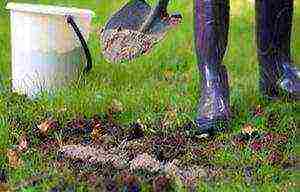 After every rain and watering it is necessary to loosen the soil and remove weeds in an earthen square of forsythia. In order for the root system to be able to saturate with oxygen, loosening should be carried out to the depth of the shovel bayonet. After this procedure, mulch the soil, this can be done with compost or dry soil.
After every rain and watering it is necessary to loosen the soil and remove weeds in an earthen square of forsythia. In order for the root system to be able to saturate with oxygen, loosening should be carried out to the depth of the shovel bayonet. After this procedure, mulch the soil, this can be done with compost or dry soil.
Plant feeding
Fertilize forsythia three times in one season, starting in early spring. To do this, in the near-trunk circle, not close to the bush, a thick layer of rotted manure is laid out, then it is plentifully spilled with water. With this method of feeding, manure is for forsythia and organic fertilizer and mulch.
In April, mineral fertilizers are applied at the rate of sixty to seventy grams per square meter. After the end of the flowering period, when the plant begins to lay fresh flower buds for the next year, it should be fertilized with kemira - wagon in the calculation of one hundred to one hundred twenty grams per square meter.
Pruning
Young plants only need sanitary pruning. To do this, cut off all dry, broken and frozen shoots. In adult bushes, with the arrival of spring, the frozen ends of the branches should be removed. The main pruning is done in the summer, after the end of the flowering period. During it, all faded shoots are shortened in half, and old and dry ones are cut, which will lead to the formation of fresh shoots.
 With the help of pruning, you can adjust the density and height of the crown, as well as the shape of the shrub. It can be spherical or cupped. If you wish to rejuvenate an adult plant, then cut all branches by four to six centimeters. This procedure activates the growth of fresh young shoots.
With the help of pruning, you can adjust the density and height of the crown, as well as the shape of the shrub. It can be spherical or cupped. If you wish to rejuvenate an adult plant, then cut all branches by four to six centimeters. This procedure activates the growth of fresh young shoots.
Keep in mind - you should not abuse such haircuts, this can lead to the fact that forsythia begins to actively grow, but it will stop blooming altogether. Anti-aging pruning should be done no more than once every three to four years, otherwise she can lose all her decorative qualities.
Pests and diseases
With good care, forsythia is resistant to various diseases and pests, but at times it can be affected by moniliosis, wilting and bacteriosis. Moniliosis can be recognized by the appearance of brown spots on the foliage. To save the plant you will need remove all affected tissue... Withering can be cured by spraying a solution of foundationol, but you cannot get rid of bacteriosis, so you have to dig out the bush along with the entire root system and burn it so that the disease does not spread to other plants.
>
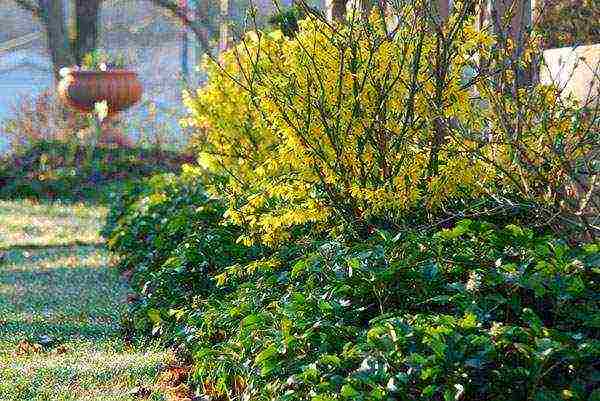 Blooming forsythia, strewn with hundreds of bright yellow flowers, is impossible to miss! If the summer resident wants to be decorated with forsythia every spring, planting and care in the open field are key stages on the path to success.
Blooming forsythia, strewn with hundreds of bright yellow flowers, is impossible to miss! If the summer resident wants to be decorated with forsythia every spring, planting and care in the open field are key stages on the path to success.
Perennial shrubs, one of the first to break the monochrome of early spring, came to Europe from Asia and were named after the botanist who brought the first seedlings to the Old World. Today forsythia is the most popular type for landscaping and creating hedges.
How and when to organize planting and caring for forsythia in the open field at their summer cottage? What does a shrub need for friendly growth?
Conditions for planting forsythia in the open field
 Forsythia is an amazing plant that changes its appearance every season. In the spring, these are branches devoid of leaves, but densely strewn with flowers. In summer, the bush is covered with greenery, which changes color to golden or purple in autumn. When looking for a place for forsythia, you should pay attention to areas where the shrub will be clearly visible and illuminated.
Forsythia is an amazing plant that changes its appearance every season. In the spring, these are branches devoid of leaves, but densely strewn with flowers. In summer, the bush is covered with greenery, which changes color to golden or purple in autumn. When looking for a place for forsythia, you should pay attention to areas where the shrub will be clearly visible and illuminated.
Although forsythia tolerate being in the shade, in the sun the bush forms more dense and even. The plant is undemanding to soil fertility, but it develops better on soil with an alkaline reaction, good drainage. Culture:
- undemanding to care;
- has excellent frost resistance, simplifying the wintering of forsythia in the open field;
- tolerates drought well;
- responds well to haircuts and can be used for growing hedges.
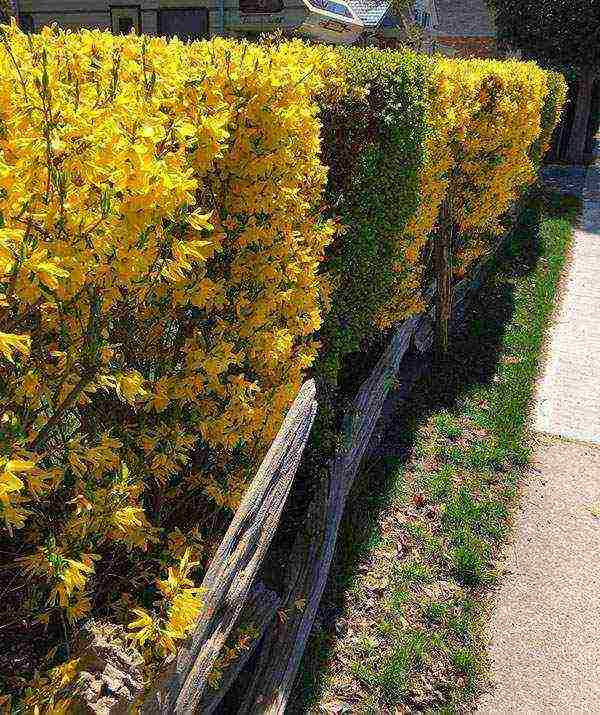 There are two options for planting forsythia in the ground: in spring and in autumn. In the first case, young shrubs immediately begin to grow after acclimatization, giving new shoots. Bushes transferred to the garden in autumn only take root, and begin to grow after wintering.
There are two options for planting forsythia in the ground: in spring and in autumn. In the first case, young shrubs immediately begin to grow after acclimatization, giving new shoots. Bushes transferred to the garden in autumn only take root, and begin to grow after wintering.
Timing of planting forsythia in the ground
The time for transferring seedlings to the garden is chosen depending on the region and the quality of the planting material. Many nurseries today offer young plants with a closed root system. Seedlings grown in containers are transplanted together with an earthen clod, so the roots do not suffer, the bush easily and quickly adapts to a new place of residence. And the summer resident is guaranteed easy care for forsythia in the open field after planting, whenever it happens: in spring, summer or autumn.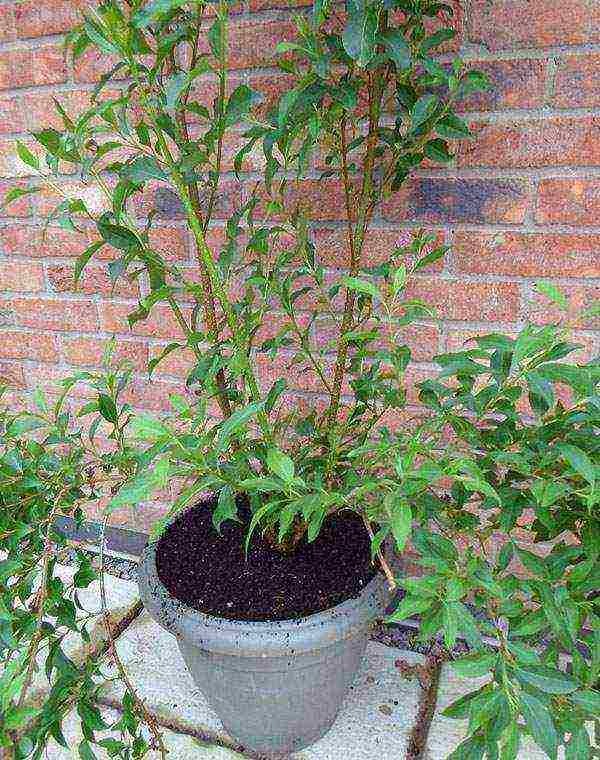
For seedlings with an open root system, it is better to plant in the spring months, when the threat of sudden frosts goes away, or in the fall, about a month before the onset of seasonal cold weather. During this period of time, the shrub will acclimatize and be able to prepare for winter.
 Since the climatic conditions in the regions of the country are seriously different, there is a significant difference in the timing of planting and caring for forsythia in the open field, in the Moscow region and, for example, in central and northern Siberia, where the heat comes later, and the summer is much shorter:
Since the climatic conditions in the regions of the country are seriously different, there is a significant difference in the timing of planting and caring for forsythia in the open field, in the Moscow region and, for example, in central and northern Siberia, where the heat comes later, and the summer is much shorter:
- If you delay planting plants in the garden, their adaptation and rooting will be delayed, and the shoots that have dedicated over the summer will not have time to get stronger before the onset of frost.
- Early spring planting threatens with the danger of freezing of the buds, tops of the shoots, and in case of severe frosts on the soil, damage to the points of growth and roots.
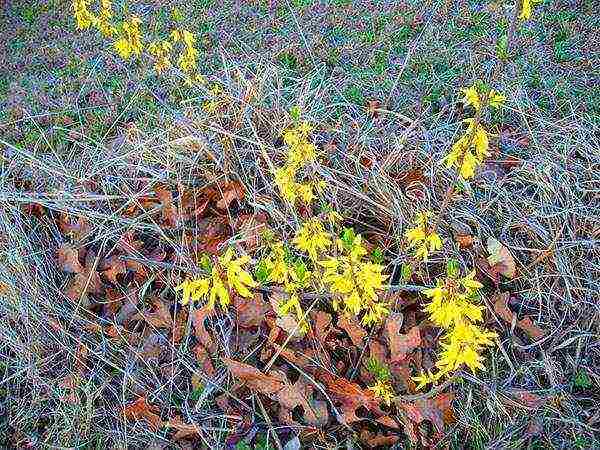 In autumn, planting forsythia in the ground also depends on weather and climatic conditions and can vary even within one region, for example, as large as the Urals. If in the south gardeners live according to a calendar similar to that used by summer residents of the middle lane, then in the north the weather is much more severe and changeable.
In autumn, planting forsythia in the ground also depends on weather and climatic conditions and can vary even within one region, for example, as large as the Urals. If in the south gardeners live according to a calendar similar to that used by summer residents of the middle lane, then in the north the weather is much more severe and changeable.
Planting forsythia in open ground
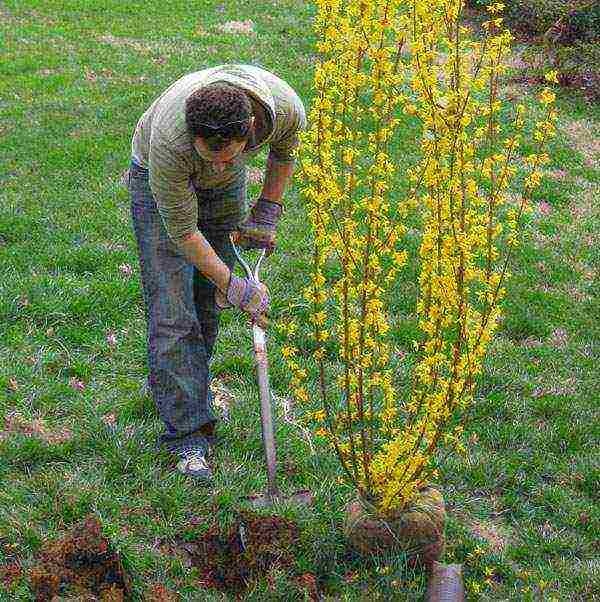 Forsythia prefer dry, drained soil and do not tolerate stagnant moisture in the soil. Therefore, at the bottom of the planting pits 60 cm deep and 50 cm wide, powerful drainage is made from broken brick, expanded clay or gravel.It is especially important not to neglect this measure in areas with dense soil that retains water and where groundwater is too close. An example is planting and caring for forsythia in the Leningrad region.
Forsythia prefer dry, drained soil and do not tolerate stagnant moisture in the soil. Therefore, at the bottom of the planting pits 60 cm deep and 50 cm wide, powerful drainage is made from broken brick, expanded clay or gravel.It is especially important not to neglect this measure in areas with dense soil that retains water and where groundwater is too close. An example is planting and caring for forsythia in the Leningrad region.
A layer of sand and a previously prepared soil mixture are poured over the drainage on the basis of:
- 2 pieces of leafy land;
- 1 part peat;
- 1 part sand.
 For each hole, 200 grams of sifted wood ash is mixed into the ground. The substrate is poured with a mound, on the sides of which the roots of the bush are spread. After filling the hole, the soil is compacted and watered abundantly at the rate of 10-15 liters per plant. In the fall, after planting forsythia, caring for the shrub consists in dense mulching of the trunk circle. This will help conserve water in the soil and protect the roots from hypothermia.
For each hole, 200 grams of sifted wood ash is mixed into the ground. The substrate is poured with a mound, on the sides of which the roots of the bush are spread. After filling the hole, the soil is compacted and watered abundantly at the rate of 10-15 liters per plant. In the fall, after planting forsythia, caring for the shrub consists in dense mulching of the trunk circle. This will help conserve water in the soil and protect the roots from hypothermia.
Mulch will help in spring, especially where summer comes quickly and the soil dries quickly, covered with a dense, impenetrable crust.
Caring for forsythia after planting in the open field
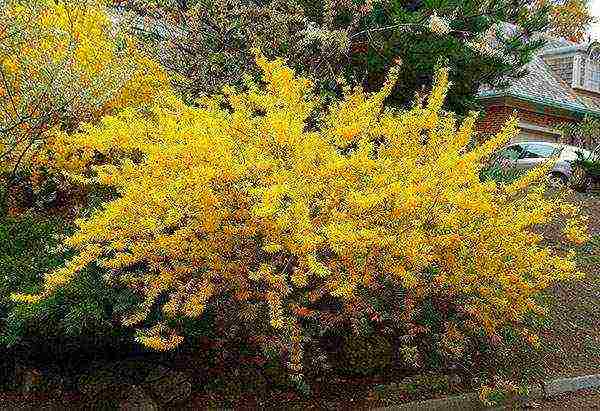 An important advantage of forsythia is its simplicity and the absence of any special care. In the warm season, shrubs that grow rapidly with minimal care need:
An important advantage of forsythia is its simplicity and the absence of any special care. In the warm season, shrubs that grow rapidly with minimal care need:
- in irrigation, if there is no natural precipitation, and the soil under the plants is completely dry;
- in maintaining the cleanliness and looseness of the trunk circles;
- in a triple feeding;
- in a haircut that helps maintain the health and shape of the crown.
In hot dry times, the plants are watered abundantly once or twice a month, the field of which is loosened, weeded and mulched. Lowland peat mixed with humus and wood ash can be used as mulch. This composition protects the roots from overheating and is an excellent long-acting fertilizer. In addition, shrubs respond well to full fertilization before and after flowering.
In the second half of summer, you should not fertilize shrubs with nitrogen. It will cause active growth of young shoots, which, even with proper planting and caring for forsythia in the Urals, Siberia and in the middle lane, will not have time to ripen and will die with the onset of frost.
An important part of caring for forsythia is pruning the shrub. For sanitary purposes, the removal of dead, old or damaged branches is carried out in the spring, and a haircut to maintain shape - in early summer, when the mass flowering ends. Until recently, shoots yellow from flowers can be shortened by half the length, and old branches are cut above the ground so that several buds remain at the base.
Once every 3-4 years, forsythia is rejuvenated by evenly cutting all shoots by half or two-thirds of the length. Over the summer, the plant will restore the crown, which will be dense, uniform and young, so that next spring it will please with a friendly bright flowering.
In most regions, the plant winters excellently without shelter. If the winters have little snow, before wintering, forsythia in the open field is gently tilted to the ground, fixed and covered with spruce branches or dense non-woven material. At the first opportunity, the bushes are covered with snow.
Reproduction of forsythia in the open field
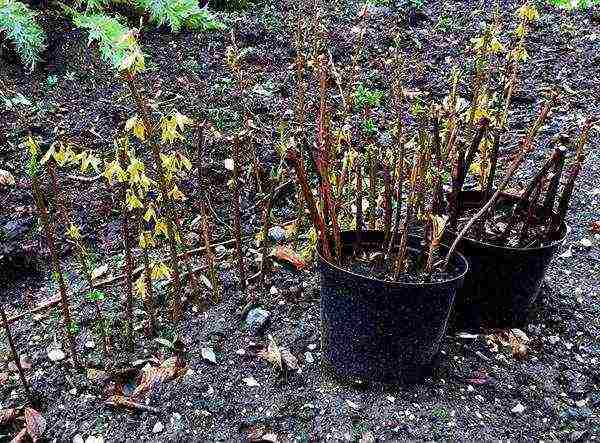 The remaining parts of the branches after pruning are an excellent material for obtaining cuttings that will serve for the propagation of forsythia. The green shoots are cut into pieces 10-15 cm long so that each one has several healthy buds. The lower leaves are cut off, and the resulting stalk, after treatment with a rooting stimulant, is planted in a greenhouse.
The remaining parts of the branches after pruning are an excellent material for obtaining cuttings that will serve for the propagation of forsythia. The green shoots are cut into pieces 10-15 cm long so that each one has several healthy buds. The lower leaves are cut off, and the resulting stalk, after treatment with a rooting stimulant, is planted in a greenhouse.
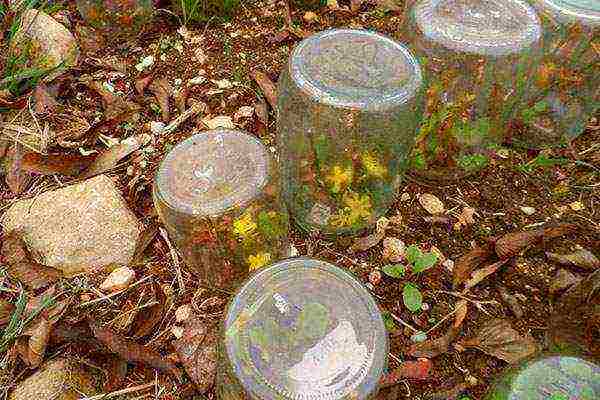 In the fall, another method for breeding forsythia in the open field is possible. Lignified cuttings are planted in a school organized in a quiet place protected from wind and flooding. For the time remaining before the cold weather, the seedling will give roots, and 2-3 buds left above the surface of the soil will wake up in the spring and form a young crown of a dwarf shrub. In the coming fall, such plants can be planted in a permanent place.
In the fall, another method for breeding forsythia in the open field is possible. Lignified cuttings are planted in a school organized in a quiet place protected from wind and flooding. For the time remaining before the cold weather, the seedling will give roots, and 2-3 buds left above the surface of the soil will wake up in the spring and form a young crown of a dwarf shrub. In the coming fall, such plants can be planted in a permanent place.
Planting forsythia in a permanent place - video
Forsythia (forsythia) is a genus of small trees and shrubs belonging to the Olive family.There are many varieties and varieties of this plant. In nature, forsythia grows in East Asia and Europe. Several species are grown outdoors. The plant is distinguished by large flowers, painted in a rich yellow color. They begin to appear in early spring. Forsythia is usually propagated by a vegetative method.
1 Common types
European forsythia
One of the most popular species of this plant is European forsythia. This variety is a low shrub, reaching a height of no more than 2 m. It is characterized by oblong leaves, growing no more than 7 cm in length, and single bell-shaped flowers. The color of the flowers is golden yellowish.
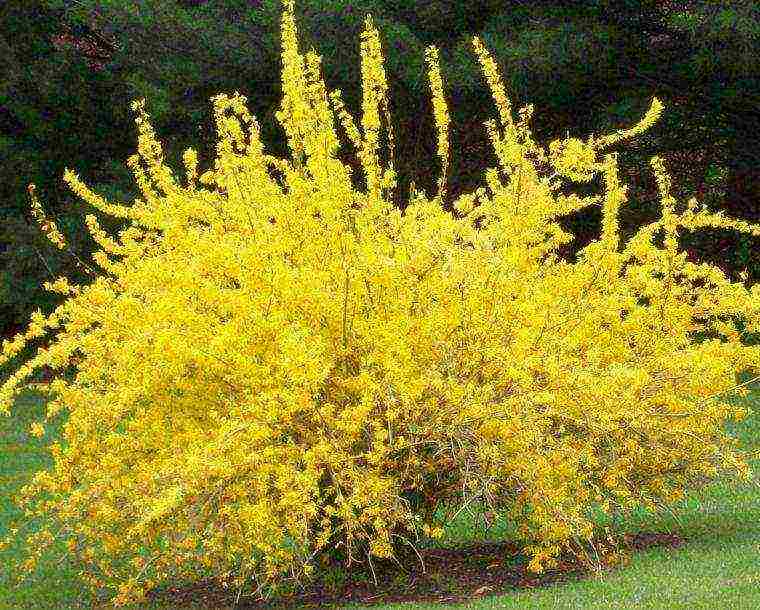
Hanging
Another common type is drooping or drooping forsythia. It is a taller shrub, reaching a height of 3 m. The crown is spreading, the branches are arched, drooping, painted in an olive or brownish tint. The flowers are large and the leaves are simple. In diameter, the flowers reach no more than 2.5 cm and are collected in bunches of several pieces.
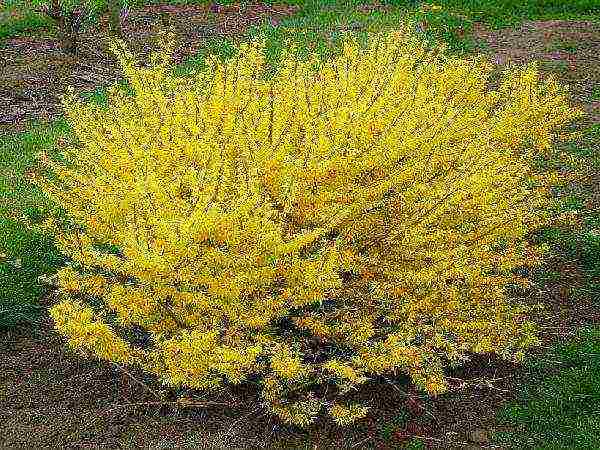
Intermediate
As a result of crossing the drooping forsythia with dark green breeders, a new variety was obtained, called the intermediate forsythia.
The description of this species is as follows:
- height - up to 3 m;
- the leaves are oblong, with jagged edges, reaching a length of no more than 10 cm, the color is saturated green, which persists until the beginning of winter;
- flowers are yellow, gathering in bunches.
Forsythia intermediate flowers appear in mid-spring. Many varieties of this species are grown in gardens and dachas. It blooms only 3 years after planting. Among gardeners, forsythia intermediate is popular due to its drought and frost resistance. This species is suitable for cultivation in the Leningrad region and Siberia.
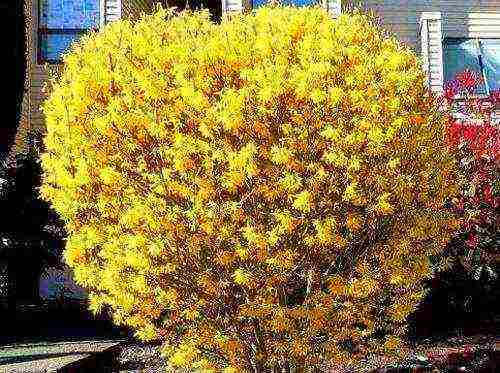
Ovoid
Grow in the open field and ovoid forsythia. The shrub reaches a height of no more than 2 m and has spreading yellowish-gray branches. It has large leaves, reaching a length of about 7 cm, and single flowers, painted in a bright yellow hue. The bush is ovoid, which explains its name. In the summer, the foliage is of a rich green color, and closer to autumn it becomes purple. This plant starts flowering much earlier than other species. Forsythia ovoid is winter hardy and is suitable for growing not only in the Moscow region, but also in Siberia.
Grouse imperial: features of planting in open ground and the nuances of care
1.1 Popular varieties

Golden Times
One of the varieties of intermediate forsythia, distinguished by its decorativeness, is the Golden Times. It is considered variegated and stands out for its jagged leaves with a yellow border. This variety grows in height no more than 2 m. Yellowish flowers appear in April - May. Suitable for growing in central Russia.
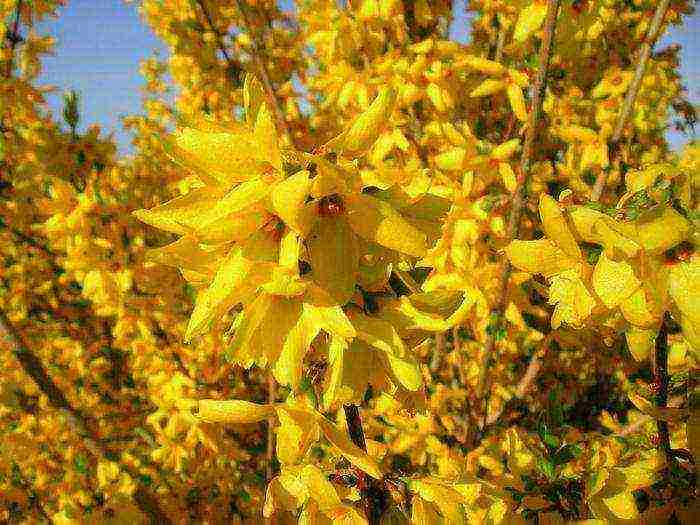
Linwood Gold
For landscaping city parks, a variety of intermediate forsythia called Lynwood Gold is used. The shrub reaches a height of about 3 m and has a spreading crown. Large yellow flowers cover bare branches for 2 weeks in late spring. After the plant fades, yellowish leaves appear on the branches.
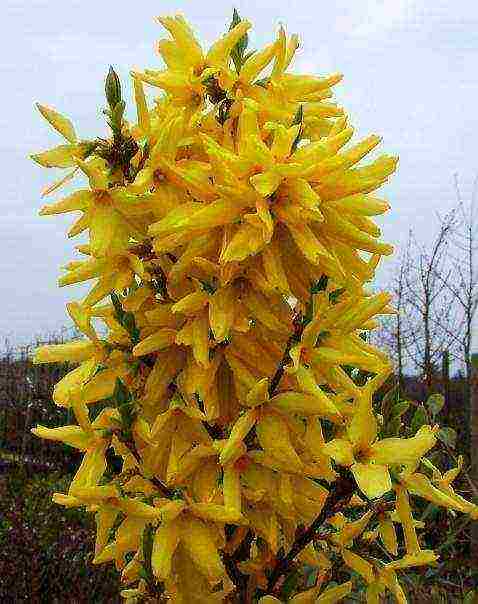
Spectabilis
Such a variety of forsythia as Spectabilis is also widespread. It is a deciduous shrub that grows no more than 3 m in height. It has a rapid growth rate, which stops about 5-10 years after planting in open ground. It begins to bloom at the end of April. The flowers are yellow and the leaves are green. With the onset of autumn, the foliage turns purple or yellowish.

Goldsauber
One of the most popular varieties of ovoid forsythia is Goldsauber. It is distinguished by powerful branches and rather large flowers, painted in a golden hue.
Rules and dates for planting tulips in open ground
2 Planting in open ground and further care
It is recommended to plant forsythia in open ground in the spring or autumn in a well-lit area. The planting site must be protected from drafts. Forsythia is undemanding to soil, but grows best in dry alkaline soil. The planting hole for the bush should be small and shallow. When planting, it should be borne in mind that the root ball must be at a depth of at least 30 cm.
The distance between two copies must be at least 50 cm.
Before planting shrubs, a drainage layer and a thick layer of sand must be laid on the bottom of the planting pit. Crushed stone or broken brick is suitable as drainage. Sprinkle on top of the soil mixture, consisting of the following components:
- sheet land (2 parts);
- sand and peat (1 part each);
- wood ash (200 g).
After being placed in a hole, seedlings should be lightly sprinkled with earth and watered abundantly. If the plant was planted in the spring, then after the procedure, you need to take care of the shrub in the same way as for an adult specimen. Forsythia, planted in the fall, requires special care. It is imperative to cover the area with breathable material.
There is no need to water the plant in summer, unless the summer is too dry. If there is little rainfall, it is necessary to water at least 1 time per month. It is advisable to pour at least 10 liters of water under one bush at a time. After the soil is moistened, it must be loosened and weeds removed, if necessary. After loosening, the trunk circle should be covered with compost.
It is recommended to apply fertilizers three times per season..
- The first feeding is carried out in early spring. A thick layer of rotted manure should be spread along the near-trunk circle and the soil should be abundantly moistened.
- It is necessary to fertilize the plant again in April, using a complex mineral fertilizer as a top dressing at the rate of 60 g per 1 sq. m.
- The third top dressing is applied during the period of flower buds. It is necessary to feed the forsythia with Kemeroi-universal at the rate of 100 g per 1 sq. m.
Young specimens undergo only sanitary pruning. Dried, broken and weakened shoots should be removed. In adult specimens, the frozen ends of the branches must be removed. The main pruning of adult forsythia is carried out in the summer. Once the plant has faded, the branches must be cut in half. Anti-aging pruning should be done once every 4 years. During this procedure, you should trim all branches by 2/3.
Clematis: planting in open ground and care features
2.1 Reproduction at home
Forsythia can be propagated at home in a vegetative way. Best for reproduction are 15-centimeter cuttings cut from the mother plant in early summer. First, you need to remove the lower leaves from the cuttings and pre-treat with a growth stimulator (Kornevin). They must be planted in the sand, under the greenhouse.
Lignified cuttings cut from a plant in mid-autumn are also suitable for reproduction. In this case, they should be planted immediately in open ground so that at least 2 buds remain above the surface. For the winter, cuttings should be covered with fallen leaves. With the onset of spring, the shelter will need to be removed.
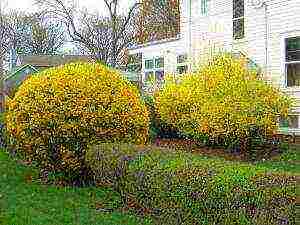 Forsythia - one of the most ancient shrubs belonging to the olive family.
Forsythia - one of the most ancient shrubs belonging to the olive family.
With the onset of spring, it blooms one of the first among the other decorative cultures.
Its yellow flowers bloom before the leaves and delight with their flowering for 2-3 weeks.
Yellow flowers give way to green leaves, and in autumn they turn lilac-red.
…
Before planting this plant, you need to decide on its type, this is mainly depends on the climatein which the flower will grow.
Although all varieties of forsythia withstand frost up to - 10 degrees, many can freeze even under a winter shelter. And this subsequently has a bad effect on growth and flowering.
For example, Forsythia is greenest and hanging very susceptible to frost, it is better to grow them in the southern regions. Forsythia ovoid and European are the most frost-resistant species.
Also learn about proper care and cultivation of cellosis.
Read here about the rules for growing aquilegia.
Details about the propagation of a home rose by cuttings:
Landing
Pits for planting this plant are prepared in advance. They are filled with the following composition: 1 part of humus, 1 part of sheet soil and 2 parts of sand.
If the acidity of the land on the site is increased, neutralized lime or chalk solution (300 - 400 g) or wood ash is added to each hole for planting (200 g).
Drainage is made of crushed stone and crushed bricks, the layer of which should be 15-20 cm. A layer of sand 6-8 cm is poured on top.
The distance between each plant should be 1.5 - 2 meters, the depth of the hole is 50 - 70 cm. Its parameters are 60x60 or 70x50 cm. It is better to plant forsythia in the fall, before frosts come.
When choosing a place, it should be borne in mind that the plant will bloom in a few years up to 3m in height and 2m in width.
Freshly planted shrubs are watered abundantly and a layer of mulch is laid (peat, humus, rotted foliage), the branches are tilted to the ground, fixed with wire and make a shelter for the plant so that it can overwinter and not freeze.
Moreover, you need to cover all types of forsythia. For these purposes, materials are used through which air penetrates. This is necessary so that the shoots and buds do not vomit during the thaw.
You can cover the bush with needles. In the spring, the material is removed from the plant, the branches are straightened, and the flooring is removed from the leaves.
Although you can plant a shrub in the spring. When buying seedlings, it is advisable to choose them with a closed rhizome. In this case, they will take root better.
Ideal drop-off location will be where there is a lot of sunshine. But also the plant should be away from drafts and wind.
But a slight partial shade will not harm the plant either. Many flower lovers prefer to plant forsythia in the country because of its unpretentiousness to watering. This is important if it is not always possible to water it in a timely manner.
The correct planting of the hazel grouse will lead to its active growth, read in detail on our website.
Also read how to make a garden var with your own hands:
Care
In early spring, before flowering shrubs you need to feed mineral fertilizers - 1m270 grams.
When the plant has bloomed and the next flower buds are laid, you can use the kemiru wagon (100 grams per m²).
If there is enough rainfall, then additional watering for the forsythia is not necessary.
It is better adapted to dry weather than excess moisture.
But still, if in summer there is a long sultry weather without rain, then once a month the shrubs must be watered with 10 liters of water under each.
After watering, the soil around the flower is loosened and compost is added.
It should be carried out regularly weeding forsythia... When weeding, it is necessary to loosen the soil with one shovel bayonet. This allows air to freely penetrate to the roots and nourish them.
At the beginning of spring, it will be beneficial for the plant mulching the ground around manure, which will at the same time be a top dressing.
The plant is very resistant to pests and diseases... When wilted, it is sprayed with zineb or foundation.
If nematodes are found, then the soil around the forsythia is disinfected with carbation. With bacteriosis, the shrub is uprooted and removed.
Pruning
For the first year or two, the young shrub is not cut off, except that the shoots that have suffered from frost. An adult bush is also relieved of frozen branches in the spring.
The main pruning work occurs in the summer, when the flowering period ends. Branches that have faded are made half shorter.
Old or dried up branches are cut off and leave only 5-6 cm from the ground level, from them new lateral shoots will grow in the future.
By pruning, you can shape the plant into a ball or bowl, and control the density and height of the shrub.
To activate growth and make the forsythia more lush in the future, it is necessary to cut it by 2/3 or even shorter once every 3 years. This is a kind of anti-aging procedure.
From the base, young shoots are activated, the number of which will be greater than before. So that the shrub does not lose its decorative appearance, it must be pruned every 3 to 4 years. If this is not done, the branches will stretch out and bloom worse.
Circumcision is performed in several stages.:
- removal of old coarse branches under the base (1/4 of the total);
- cutting off dead branches and thinning thick bushes;
- shortening of faded shoots by ½ of their length, taking into account the decorative type of forsythia.
Gladiolus is a favorite flower of summer residents. Learn how to store gladiolus bulbs so they don't go missing next year.
Features of transplanting clematis in the spring:
Reproduction
The plant propagates quite simply - by layering, cuttings, and less often by seeds.
Layers
This method is most often used because of its simplicity.
If forsythia branches bend to the ground, and they will come into contact with it for a long time, then they will soon take root themselves.
But it is better to monitor the reproduction yourself and choose the best branch, bending it to the ground and digging it in.
It is necessary to cut the bark in the place where the branch is dug. In the spring, when the shoot takes root, it can be transplanted from the main bush to another location.
In a year, the young forsythia will already bloom.
Cuttings
This method is also quite simple. Can multiply lignified and young shoots... Young green cuttings are cut in early summer.
To begin with, they are kept in a solution from the root for some time, they are planted with a priest in specially prepared soil and covered with a film so that create greenhouse conditions.
Already in the fall, the cutting will take root and take root well.
At this time, it can be assigned to a permanent place and covered with a ball of dry foliage for the winter.
Lignified cuttings are cut for planting in the fall. Their length should be up to 18 cm. They are planted in the ground 10 cm deep. Several buds are left on the surface. In order for the plant to overwinter, it is covered with dry leaves.
Seeds
This method is rarely used. The percentage of seed germination in the region of 40%. Them sown in boxes with soil in spring... The first shoots appear in a month.
During the year, young shoots grow up to 6 cm. In the second year they can grow up to 30 cm, they can already be planted in open ground and left to winter under a thick layer of leaves.
The first flowering of such a shrub occurs in the 4-6th year of life.
Forsythia is a good option for gardeners and summer residents. With this shrub, you can create a vibrant colorful fence. In addition, having given it the desired decorative shape, you can organically fit it into the landscape design of any site.
Forsythia (Forsythia) or forsythia is a plant in the form of shrubs or small trees. It is a member of the Olive family. The main feature of forsythia is considered to be its early flowering, the bush is covered with bright yellow flowers in early spring, long before its first leaves appear.
This genus is one of the most ancient on earth. First of all, this is proved by a very wide natural habitat. Six types of forsythia originate from East Asian countries such as Japan, China and the Republic of Korea. Only one species grows in Europe Forsythia europaea or translated from Latin European forsythia. Most often it can be found in the Balkan Peninsula and in Germany.
The plant got its name thanks to the Scottish botanist William Forsyth. He is one of the founders of the Royal Horticultural Society, and is also known for being the main gardener of Kensington Palace for a long time. It was William who introduced forsythia to Europe, borrowing it from the wild flora of China.
> Description
Forsythia grows in the form of small trees or bushes. She can reach from one to three meters in height... The trunk of this plant is covered with rough gray-brown bark. Most species have simple opposite leaves without stipules. They are oval in shape with jagged edges, can be from two to fifteen centimeters in length. On the shoots they are arranged crosswise - in pairs, two at each node. Some species boast trifoliate leaves, their plate is divided into three parts: two lateral and one central.
The forsythia bloom period begins in early spring and lasts on average up to three weeks, but sometimes it can last longer. The inflorescences are bright yellow in color, consist of flowers that resemble bells in their shape. In their place, the fruits of the plant are formed - capsules filled with winged seeds.
Forsythia begins to bloom long before the first foliage appears, then the flowers are replaced by green leaves, which acquire a purple hue closer to autumn.
Types and varieties
Forsythia - spring messenger, with its aroma and bright, sunny bloom, it decorates gray streets and reminds people of the imminent arrival of heat. To date, within the framework of botany, seven main species of this beautiful flowering plant have been recorded:
Forsythia europaea or European forsythia.
- Forsythia ovata or ovoid forsythia.
- Forsythia x intermedia or intermediate forsythia.
- Forsythia hanging, drooping or drooping - Forsythia suspensa.
- Forsythia abeliophyllum - Snow or white forsythia.
- Forsythia viridissima or dark green forsythia.
- Forsythia giraldiana or forsythia giralda.
Let's take a closer look at the most popular ones.
> European forsythia
This species is considered the most common in Russia. Such popularity is due to the unpretentiousness of the plant and its frost resistance - it is able to develop well and bloom even in climatic conditions of middle latitude and Siberia.
Forsythia European looks like a short one upright shrub... She can only grow up to two meters in height. She has oblong, whole-edged (without denticles and grooves) leaves up to seven centimeters in length. The flowers grow singly, their shape is similar to bells and are colored yellow with a golden tint.
Forsythia ovoid
Ovate forsythia is a small shrub that grows from one and a half to two meters in height... They have spreading branches covered with gray bark with a yellowish tinge. The leaves can be up to seven centimeters long. In summer, they are painted in bright green, and closer to autumn they acquire a purple hue.
Bright yellow inflorescences consist of single, medium-sized flowers with a diameter of up to two centimeters. The flowering period of this species begins earlier than that of other forsythia.
Plants tolerate winter cold, dry periods well and grow quite quickly. The most popular varieties related to this species:
- Tetragold - shrub rarely exceeding one meter in height. The flowering period begins in mid-April. Inflorescences consist of single dark yellow flowers with a diameter of up to three centimeters.
- Goldsauber - is considered a very valuable variety. It is very popular among gardeners due to its large yellow flowers with a golden hue and frost resistance. The flowering period begins in April and lasts about three weeks.
- Spring Glory - shrub up to three meters in height. In summer, the crown has a rich green color.Closer to autumn, it acquires an additional shade from pale yellow to dark purple, which is why it becomes quite variegated. The bloom is very abundant, the flowers are large, painted in a bright yellow color.
> Intermediate forsythia
Intermediate forsythia is a hybrid created by crossing dark green and drooping forsythia. It grows up to three meters in height and begins to bloom only in the fourth year after planting.
She has oblong leaves, up to ten centimeters in length... They are most often toothed, but plants with trifoliate foliage can be found. The crown is painted in a dark green color, which does not change until late autumn. Bright yellow flowers form inflorescences of several pieces. The flowering period runs from April to May. The species is very winter-hardy, drought-resistant, grows quickly and well. Varieties:
- Spectabilis - is considered a very beautiful variety. The bushes are low, only a meter high. The main feature is the crown of this species. It is very thick and lush, can reach one hundred and twenty centimeters in diameter. In summer, the foliage is colored green, in autumn it turns purple or bright yellow.
- Denziflora —Small bush, can reach one and a half meters in height or less. The volume of the crown is usually equal to the height of the plant. The flowers are twisted, have a pale yellow color. It begins to bloom in March, the inflorescences last for about two to three weeks. This variety is afraid of frost.
- Beatrix Farrand - bushes up to four meters high. The flowers are bright yellow with dark yellow stripes at the base.
Planting forsythia
The early onset of the flowering period favorably distinguishes forsythia against the background of other shrubs. Unpretentiousness to the location and care only add to its popularity among flower growers. Noting some of the features that should be considered when growing this wonderful flowering bush:
- This plant is very light-requiring, but grows well even in the shade.
- Forsythia prefers calcareous soils.
- Closer to autumn, the green crown of the bush acquires a golden or purple-violet hue, which again attracts the attention of all passers-by.
- Experienced gardeners prefer to place forsythia against the background of dark green conifers, since in such a place it looks most impressive.
When to plant forsythia
Transplanting and planting forsythia should be done in the spring or early fall, before the onset of frost, so that it can take root even before winter. The most suitable place for this plant, with good lighting and partial shade, well protected from wind and drafts. Of course, forsythia feel good even in the shade, but nevertheless, it is better to choose bright places for heat-loving bushes.
The composition of the soil for the plant does not really matter, but it takes root and develops best in slightly alkaline dry soils. If your site has rather acidic soil, dig up the ground beforehand diluting it with wood ash.
How to plant forsythia correctly
Let's start planting forsythia:
- After you have chosen a place for forsythia on your site, it is time to prepare the planting pits. The optimal size is 50 to 50 to 60, in such cases the earthen lump will be at a depth of thirty to forty centimeters, as required.
- If you decide to plant several bushes in close proximity to each other, then the distance between the holes should be not less than thirty to forty centimeters.
- Prepare nutrient soil. To do this, mix one kilogram of leafy soil, five hundred grams of sand, half a kilogram of peat and two hundred grams of wood ash.
- Fill the planting hole with a good layer of drainage material. For these purposes, expanded clay, broken brick or crushed stone are most often used. The thickness of the drainage layer should be fifteen to twenty centimeters.
- Fill the drain with sand. The sand layer should be ten centimeters thick.
- Cover the sand with nutritious soil.
- Place the seedlings in the planting holes, sprinkle with soil and compact wellto give the plant stability and avoid gaps between the roots.
- Sprinkle the seedlings liberally after planting.
If you planted bushes in the spring, then they will need regular care. Forsythia, planted in autumn, requires more attention. Without fail, the root square will need to be mimicked, regardless of whether the plant belongs to a particular species. For the winter, the seedlings should be covered with a special material. It must be breathable so that the flower buds do not get blocked in the event of winter thaws.
> Care for forsythia
Caring for forsythia in the open field is not much different from caring for any garden shrub. If there is sufficient precipitation in the summer, the plant does not need additional watering. But if it turns out to be arid, you will have to spill forsythia about one or two times a month, ten to twelve liters for each bush.
After every rain and watering it is necessary to loosen the soil and remove weeds in an earthen square of forsythia. In order for the root system to be able to saturate with oxygen, loosening should be carried out to the depth of the shovel bayonet. After this procedure, mulch the soil, this can be done with compost or dry soil.
Plant feeding
Fertilize forsythia three times in one season, starting in early spring. To do this, in the near-trunk circle, not close to the bush, a thick layer of rotted manure is laid out, then it is plentifully spilled with water. With this method of feeding, manure is for forsythia and organic fertilizer and mulch.
In April, mineral fertilizers are applied at the rate of sixty to seventy grams per square meter. After the end of the flowering period, when the plant begins to lay fresh flower buds for the next year, it should be fertilized with kemira - wagon in the calculation of one hundred to one hundred twenty grams per square meter.
Pruning
Young plants only need sanitary pruning. To do this, cut off all dry, broken and frozen shoots. In adult bushes, with the arrival of spring, the frozen ends of the branches should be removed. The main pruning is done in the summer, after the end of the flowering period. During it, all faded shoots are shortened in half, and old and dry ones are cut, which will lead to the formation of fresh shoots.
With the help of pruning, you can adjust the density and height of the crown, as well as the shape of the shrub. It can be spherical or cupped. If you wish to rejuvenate an adult plant, then cut all branches by four to six centimeters. This procedure activates the growth of fresh young shoots.
Keep in mind - you should not abuse such haircuts, this can lead to the fact that forsythia begins to actively grow, but it will stop blooming altogether. Anti-aging pruning should be done no more than once every three to four years, otherwise she can lose all her decorative qualities.
Pests and diseases
With good care, forsythia is resistant to various diseases and pests, but at times it can be affected by moniliosis, wilting and bacteriosis. Moniliosis can be recognized by the appearance of brown spots on the foliage. To save the plant you will need remove all affected tissue... Withering can be cured by spraying a solution of foundationol, but you cannot get rid of bacteriosis, so you have to dig out the bush along with the entire root system and burn it so that the disease does not spread to other plants.
blockquote>
In early spring, the suburban areas look deserted, as not a single plant has yet departed after a cold winter. However, a bright spot can be seen among the bare bushes. This is forsythia blooming. This plant is very unusual. The fact is that flowers appear on it even before leaves begin to form on the trunk. Beautiful yellow flowers become a real decoration of any suburban area.
Description
Forsythia combines several types of low trees and shrubs. Moreover, there are more than a hundred varieties of this plant. Popularly, this flower is also often called golden lilac. It's all about early flowering.
In its natural environment, golden lilac grows on almost all continents. Therefore, we can conclude that the plant appeared in nature hundreds of years ago.
Outwardly, forsythia resembles a stunted tree on which drooping branches grow. The leaves of the plant are oval. The flowers are like yellow bells. However, depending on the type, they can have a wide variety of shapes. On some plants, flowers have longer stamens and stamens, while others have a more miniature pedicel.
Types and varieties
If we talk about the varieties of forsythia, then the entire huge variety of plant varieties can be divided into two groups: non-frost-resistant and frost-resistant. Representatives of the first category are suitable for growing exclusively in the southern regions. In central Russia, frost-resistant flowers grow well. Their most striking representative is intermediate forsythia (middle). This flower was artificially bred, so, in fact, it is a hybrid. The plant of this species is a shrub that can reach a height of 3 m. The leaves of the intermediate forsythia are slightly elongated and have an oval shape. The flowers are bright yellow. This hybrid was specially bred for growing in regions where the temperate climate prevails. That is why the plant tolerates dry weather and frost well.
It is worth considering the description of intermediate forsythia, or rather, the best varieties for growing this hybrid:
- Densifloria. Forsythia "densifloria" is distinguished by spreading branches. The flowers of this plant are pale yellow in color, grow in dense groups.
- Pomulina. This plant begins to bloom very early. Forsythia leaves are wavy. At the same time, they begin to grow right at the base of the shoots.
- Spectabilis. Forsythia intermediate "spectabilis" is considered the most beautiful representative of its kind. It is distinguished by lush yellow branches on which very large flowers of a golden hue grow. In this case, the size of one bud can be up to 5 cm.
Most common varieties in Europe
In European cities, the following varieties of intermediate forsythia are very fond of:
- Spring Gloria. On shrubs up to 3 meters high, huge clusters of yellow flowers of extraordinary beauty grow. It is not surprising that the plant is called the spring beauty.
- Lynwood Variety. Forsythia intermediate "linwood" is considered one of the most hardy plants. The main advantage of this flower is that it grows very quickly.
- Feista. This variety will appeal to those who prefer to grow more compact plants in a suburban area. However, despite the size of forsythia, very beautiful large flowers appear on it.
- Week-End. Forsythia intermediate "weekend" is characterized by straight branches that go down almost to the ground.
- Primulina. This variety is also small in size. The branches of the flower are light yellow, so they look harmonious with bright inflorescences.
In addition, in Europe they are very fond of planting intermediate forsythia "golden time", "giant arnold", "parkdecor" and some other varieties in suburban areas.
Growing
Many gardeners believe that it is very difficult to grow this plant. In fact, care and planting of forsythia in the open field does not require much effort. This hybrid does not need a special lighting mode. At the same time, he calmly tolerates heat and rare watering. You can feed the plant with almost any component. But even without fertilization, the plant will feel great.
However, this does not mean that forsythia does not need attention at all.In order for the plant to bloom well, it is worth paying attention to some recommendations.
Wintering
Everyone knows that flower buds begin to re-form immediately after the plants have faded. This means that in the winter, tiny embryos continue to develop. If the shrubs are not covered for the frost period, then only the lower buds can bloom in the spring.
To prevent this from happening, this nuance must be taken into account in the process of leaving and planting forsythia in the open field. To protect the hybrid shrub in winter, you can use pine spruce branches, fallen leaves or cut grass. It is also worth purchasing nonwovens, which can be found without any problems in specialized gardening stores.
It is not recommended to use polyethylene, as in this case the plant will have nothing to breathe and it may start to rot.
Pruning
This procedure must be performed in order for the intermediate forsythia to bloom magnificently.
Trimming too early is not recommended. In this case, new kidneys will not develop well. Therefore, it is worth cutting the plant before the beginning of the growing season. It is best to do the work in the spring, after the plant has faded. Once every 3-4 years old or affected shoots should be removed.
Location
Forsythia intermediate grows well in dark areas, but blooms better in good light conditions. It is much more important to protect the bushes from the wind, so it is worth choosing a fairly closed place for it.
When planting several plants of this species at once, their dimensions should be taken into account. It is best to have at least 1.5-2 meters between the plants. It is necessary to plant golden lilacs in pits with a depth of at least 0.5 m.The width of the landing hole should also be about 0.5 m.
If the soil on the site is acidic, then it is enough to add slaked lime or wood ash (200-300 g per hole) to it.
Why does the plant not bloom
If there are no flowers on the bush or there are very few of them, then this may indicate a lack of nutrition. To solve this problem, it is enough to start feeding the plant, especially you need to pay attention to the introduction of fertilizing before the beginning of autumn.
It is best to fertilize the hybrid the first time after the snow melts. To do this, manure must be brought into the near-trunk area and thoroughly loosened. It is recommended to fertilize the plant a second time in April, before flowering. In this case, mineral complexes must be added to the ground. The third time feeding is done after the end of flowering. During this period, it is necessary to supply the shrub with a complex composition of fertilizers.
If you feed forsythia in a timely manner, then it will constantly delight you with fluffy and abundant flowering.
Diseases and pests
By and large, this shrub is resistant to most ailments and parasites. However, it is worth taking care of a fragile plant that was planted quite recently. Very often, young shrubs suffer from fusarium. This fungal disease causes the hybrid to wilt. A black mold-like coating may appear on its trunk. If this happens, then it is imperative to add "Fitosporin", "Gamair", "Trichophyte" or any other preparation of similar action to the soil.
Sometimes forsythia suffers from monoliosis. This disease manifests itself as brown dry spots on foliage and bush shoots. The plant appears to have received severe burns. For treatment, it is also necessary to start using fungicides as soon as possible.
If we talk about pests, then most often it is attacked by nematodes and aphids. You can get rid of these parasites with the help of specialized or folk remedies. However, if the pest colony has grown to an enormous size, then it is most effective to use insecticides.
Much less often, the shrub is attacked by the larvae of the golden-tailed moth or scoop.If their nests have formed on the plant, then they must be removed and burned as soon as possible so that they cannot spread throughout the entire suburban area.
Other pests and diseases do not affect this plant.
Growing an unusual plant doesn't involve a lot of hassle. Forsythia feels great without leaving at all, however, in order for it to please with abundant flowering, it is worth periodically applying fertilizers and protecting the shrub from hypothermia. This plant will be an excellent decoration for a suburban area. It can be used for landscaping.
Date of publication:Landing in open ground


